- Home
- Gustave Flaubert
Three Tales Page 3
Three Tales Read online
Page 3
Nowhere else, in all his fiction, does Flaubert ever show his hand in this way. He is professionally invisible. What are we to make of this bizarre exception?
There is indeed a Saint Julian window in the cathedral at Rouen, and the cathedral is indeed only half a mile from the house where Flaubert was born. That much is true. But if we compare the pictures in the window with the principal features of the tale we are baffled by the disparity between image and text. Flaubert pictured the probable scene with some relish. In a letter to his publisher, discussing the possibility of an illustrated edition of ‘The Legend of Saint Julian Hospitator’, Flaubert imagined his readers saying: ‘I don't understand it at all. How did he get this out of that?’ The last sentence of the tale is evidently a kind of joke, a piece of solemn authorial mischief that works at many different levels.
Rather than puzzling over the window we might do better to look at the thirteenth-century text of the legend of Saint Julian. Here it is, as translated and published by William Caxton, in 1483.
Another Julian there was that slew his father and mother by ignorance. And this man was noble and young, and gladly went for to hunt. And one time among all other he found an hart which returned toward him, and said to him, thou huntest me that shall slay thy father and mother. Hereof was he much abashed and afeard, and for dread, that it should not happen to him that the hart had said to him, he went privily away that no man knew thereof, and found a prince noble and great to whom he put him in service. And he proved so well in battle and in services in his palace, that he was so much in the prince's grace that he made him knight and gave to him a rich widow of a castle, and for her dower he received the castle. And when his father and mother knew that he was thus gone they put them in the way for to seek him in many places. And so long they went till they came to the castle where he dwelt, but then he was gone out, and they found his wife. And when she saw them she inquired diligently who they were, and when they had said and recounted what was happened of their son, she knew verily that they were the father and mother of her husband, and received them much charitably, and gave to them her own bed, and made another for herself. And on the morn the wife of Julian went to the church, and her husband came home whiles she was at church, and entered into his chamber for to awake his wife. And he saw twain in his bed, and had weened that it had been a man that had lain with his wife, and slew them both with his sword, and after, went out and saw his wife coming from church. Then he was much abashed and demanded of his wife who they were that lay in his bed, then she said that they were his father and his mother, which had long sought him, and she had laid them in his bed. Then he swooned and was almost dead, and began to weep bitterly and cry, alas! caitiff that I am, what shall I do that have slain my father and my mother? Now it is happened that I supposed to have eschewed, and said to his wife: Adieu and farewell, my right dear love, I shall never rest till that I shall have knowledge if God will pardon and forgive me this that I have done, and that I shall have worthy penance therefor. And she answered: Right dear love, God forbid that ye should go without me, like as I have had joy with you, so will I have pain and heaviness. Then departed they and went till they came to a great river over which much folk passed, where they edified an hospital much great for to harbour poor people, and there do their penance in bearing men over that would pass.
After long time S. Julian slept about midnight, sore travailed, and it was frozen and much cold, and he heard a voice lamenting and crying that said: Julian come and help us over. And anon he arose, and went over and found one almost dead for cold, and anon he took him and bare him to the fire and did great labour to chauffe and warm him. And when he saw that he could not be chauffed ne warm, he bare him in to his bed, and covered him the best wise he might. And anon after, he that was so sick and appeared as he had been measell, he saw all shining ascending to heaven, and said to S. Julian his host: Julian, our Lord hath sent me to thee, and sendeth thee word that he hath accepted thy penance. And a while after S. Julian and his wife rendered unto God their souls and departed out of this world.
Flaubert's ‘Legend of Saint Julian Hospitator’ evidently follows the outline of the original legend. But there is one very big difference. This Julian is obsessed with hunting. As a young boy he discovers a perfectly lascivious pleasure in the killing of small animals. He then carves his way through the entire catalogue of the animal kingdom, a veritable massacre of the innocents, beginning with a little white mouse and ending with a large and majestic stag. Flaubert's version of the hunting theme is explicitly sadistic. We are made to watch as Julian strangles a wounded pigeon, fainting with pleasure as he feels the creature's final convulsions. Yet Flaubert is infinitely more imaginative than any of De Sade's cartoon-like tormentors. In this tale he has the creatures turn against their persecutor, driving him into a state of impotent rage. In this condition he murders his father and mother, by mistake.
Where does it come from, the extraneous theme of Julian's sadism? Is it the sour exhalation of his creator? There is plausible evidence for this possibility. And yet Flaubert's sadism, if we must call it that, is uncomfortably complex, for it struggles with a benevolent compassion.
A dream dating from 1845, when Flaubert was in his early twenties, dramatizes this original ambivalence. The dream was written down, so Flaubert explained, three weeks after it had been dreamt. The delay hints at the persistent power of the dream. It also implies that the original material of the dream had been variously worked over, in the waking imagination, before Flaubert told himself to put it all in writing. Here is the text of the dream.
I was in a great forest full of monkeys; my mother was walking with me. The further we went the more there were; they were up in the branches, laughing and jumping about; they came across our path, lots of them, bigger and bigger, more and more of them. They were all looking at me and I began to feel frightened. They gathered around us in a circle; one of them wanted to stroke me and took my hand, I gave it a bullet in the shoulder that made it bleed and it made a dreadful howling noise. Then my mother said to me, ‘Why did you hurt him when he's your friend? What's he done to you? Can't you see that he loves you? He looks so like you!’ And the monkey was looking at me. It broke my heart and I woke up… feeling my own deep affinity with the animals, fraternising with them in a tender pantheistic union.22
The essential ingredients of the dream – the fear, the killing, the reproach, the sorrow, the reparation – have been preserved, elaborated and disguised in the story. Thirty years after the initiating dream, Flaubert was unusually careful to give nothing away about this his most darkly enigmatic work. In the letters that he wrote alongside ‘The Legend of Saint Julian Hospitator’ he ridiculed the whole enterprise. It was merely ‘a little religioso-poetico-medievalesque-rococo storyette’, so delightfully edifying that its author will be suspected of lapsing into clericalism.23
The mockery is a way of saying Keep Out. Saint Julian was a subject he had chosen long ago. By the time Flaubert came to write about it, it had been with him for most of his life. Slowly and fondly elaborated, Flaubert's saint was a half-private creation, a secret thing of his own that might one day be passed off as a Saint Julian. Had he chosen it? Or had it chosen him? He sometimes confessed, jokingly, that it was probably the latter.
‘Herodias’, the final tale in the collection, is an exotic fable of sexual-political corruption, the grand finale of Flaubert's romantic orientalism, that unstable nineteenth-century compound of erotic reverie and conscientious erudition. The art market of Flaubert's day was already crowded with such exotica. The pre-bourgeois world furnished an ample supply of seductively colourful stuff, all available to be lucratively processed into grand opera, history painting, salon sculpture and fancy-dress fiction. By comparison with many of his contemporaries, Flaubert practises an exemplary sobriety. He works his large antique subject against the grain, avoiding the obvious, jumbling his rich narrative ingredients of religion and politics.
Readers
of ‘Herodias’, however expert, will sometimes confess to a certain confusion. But these confusions are deliberate, a distinctive feature of the story. ‘Herodias' is such an uncommonly elliptical piece of story-telling that it requires at least a brief account of the larger political context to make it accessible to the modern reader. ‘Herodias’ is set in Judaea (southern Palestine), at the time of Christ's ministry. This is a world of priests and kings. Great temples and fortresses dominate the human scene. Subject to Rome, the Jewish people are smouldering with messianic hopes of liberation. Herod Antipas, their puppet-king, and the protagonist of ‘Herodias’, is scheming to ensure his own political survival. The king must urgently decide what to do with his prisoner, a man referred to in the tale as Jokanaan, though better known to posterity as John the Baptist. (Flaubert's trick, here and elsewhere, is to divulge the familiar name just once and then to suppress it, to make it strange again, to tell the story in tight close-up, from within the narrow, anxious mind of the king, a mind clouded by intrigue and perfectly ignorant of the coming of Jesus.)
Herod Antipas (21 BC–AD 39) became Tetrarch (ruler appointed by Rome) of Galilee and ruled throughout Jesus' ministry. Herod Antipas is often referred to in the story as the Tetrarch, or as Antipas. He divorced his first wife, daughter of the king of the desert kingdom adjoining his own, to marry his niece Herodias, formerly the wife of his half-brother. The marriage offended his former father-in-law and alienated his Jewish subjects. John the Baptist reproached Herod for this marriage, as a transgression of Mosaic law. Herodias has goaded her husband into imprisoning him. This is the point at which Flaubert's tale begins.
‘Herodias’ reverses the larger pattern of ‘The Legend of Saint Julian Hospitator’. In this tale there is no parricide and no reconciliation. The Father-King has had the Son-Prophet imprisoned for denouncing his sexual-political corruption. Yet the prophet's voice rises up from the deep hole in the ground, condemning the king in the name of the moral law. The prophet is murdered, at the king's command. This time there is no twist, no supernatural escape from the prosaic reality of death and mutilation. With the cruel humour of the folk tale, the decapitation of Jokanaan is a trick played on the king, a gruesome detumescent joke at his expense, brought about because he has lusted helplessly after a girl young enough to be his daughter. We are left gazing at this severed head, a ‘gruesome object on the plate among the remains of the banquet’. The faithful will assert that the spirit of the prophet has ‘gone down among the dead to proclaim the coming of Christ’, but this severed head still poses a stubbornly practical problem for his disciples. They set off with it, in the direction of Galilee. ‘Because the head was very heavy,’ so says the last line of the story, ‘they took it in turns to carry it.’ A conclusion quite inscrutably prosaic.
Three Tales was surprisingly well reviewed in 1877. Here was recognition at last, though it came several years too late to assuage Flaubert's bitter sense of having been disregarded for so long. Here was a conspiracy of approval, gratifying of course, but also slightly embarrassing to an author who had been so resolutely misunderstood for the last ten years.
His reviewers praised the eloquent diversity of the collection. ‘A Simple Heart’ was wholesome and profoundly moving, something for the common reader. ‘The Legend of Saint Julian Hospitator’ offered the darker pleasures of the conte fantastique, so central to French romantic writing. ‘Herodias’ was the grand finale, a ripe autumnal specimen of the conte orientale, something for the connoisseur, cruel and magnificent, like a painting by Delacroix.
After Madame Bovary, this remains Flaubert's most immediately rewarding work. On the evidence of his Three Tales, Flaubert could plausibly claim to have reinvented the short story as well as the novel. His influence has been so pervasive that lists of his followers soon begin to look dubiously inflated. Here is my own dubious scratch crew of Flaubertistes: Guy de Maupassant, Emile Zola, Henry James, Kate Chopin, Anton Chekhov, Joseph Conrad, George Moore, Paul Valéry, James Joyce, Ezra Pound, Isaac Babel, Franz Kafka, Graham Greene, Albert Camus, Czeslaw Milosz, Robert Lowell, Jean Rhys, Bruce Chatwin, Angela Carter and Raymond Carver. The list is not yet closed, because Flaubert remains our contemporary. Contemporary realism is still stubbornly Flaubertian, because we still need the peculiar intimate power of art, the power that sends strange shivers all through the majestically corpulent mass of the body politic.
NOTES
1. G. Flaubert, Correspondance, vol. i, ed. J. Bruneau (Paris: Galli-mard, 1973), p. 378.
2.Ibid., vol. 3 (1991), p. 536.
3. Ibid., pp. 16–17.
4. Ibid., vol. 1 (1973), p. 712.
5. Ibid., p. 120.
6. Ibid., vol. 2. (1980), p. 218.
7. J. Bruneau, Les Débuts littéraires de Gustave Flaubert (Paris: Armand Colin, 1962), p. 381, n. 96.
8. Flaubert, Correspondance, vol. 2 (1980), p. 285.
9. Ibid., vol. 3 (1991), p. 59.
10. Ibid., vol. 2 (1980), p. 290.
11. Ibid., vol. 3 (1991), p. 572.
12. M. Du Camp, Souvenirs littéraires (Paris: Hachette, 1882), vol. 1, p. 248.
13. Flaubert, Correspondance, vol. 4 (1998), p. 904.
14. Flaubert–Sand: The Correspondence, ed. A. Jacobs, trans. Francis Steegmuller and Barbara Bray (London: Harvill, 1993), p. 398.
15. G. Flaubert, Euvres complètes (Paris: Club de I'Honnête homme, 1971–5), vol. 15, p. 458.
16. Madame Bovary, trans. G. Wall (Harmondsworth: Penguin, 1992), pp. 120–21.
17. Flaubert, CEuvres complètes, vol. 15, pp. 471, 476.
18. Ibid., p. 475.
19. Ibid., p. 480.
20. Ibid., p. 463.
21. Ibid., p. 481.
22. Quoted in A. W. Raitt, Flaubert: Trois contes (London: Grant and Cutler, 1991), pp. 54–5.
23. Flaubert, Euvres complètes, vol. 15, p. 506.
Further Reading
Barnes, J., Flaubert's Parrot (London: Cape, 1984).
Berg, W. J., Saint/Oedipus: Psychocritical Approaches to Flaubert's Art (Ithaca, NY: Cornell University Press, 1982).
Brombert, V., The Novels of Flaubert: A Study of Themes and Techniques (Princeton: Princeton University Press, 1966).
Felman, S., ‘Flaubert's Signature The Legend of Saint Julian the Hospitable’, in Naomi Schor and Henry Majewski (eds.), Flaubert and Postmodernism (Lincoln: University of Nebraska Press, 1984), pp. 46–75.
Genette, G., ‘Demotivation in Herodias’, in Schor and Majewski (eds.), Flaubert and Postmodernism, pp. 193–201.
Raitt, A. W., ‘The Composition of Flaubert's Saint Julien l'Hospitalier’, French Studies, 19 (1965), pp. 358–72.
—— Flaubert: Trois contes (London: Grant and Cutler, 1991).
Wall, G., Flaubert: A Life (London: Faber, 2001).
Translator's Note
The translation is based on the 1988 Classiques Gamier edition of Trois Contes by P. M. Wetherill, which reproduces, in Professor Wetherill's words, ‘as faithfully as possible, the text of Flaubert's final manuscript’.
Flaubert's final manuscript presents a considerable challenge to the editor. It is strewn with crossings-out, marginal notes and rewritings – a clear indication of Flaubert's search for historical, geographical and technical precision and for stylistic poise. Yet in his determination to get things just right, Flaubert left many finer points of expression (punctuation in particular) ill-defined. Since the first published edition of the collected tales in 1877, editors have attempted in different ways to make good these lapses. Professor Wetherill has produced an edition which is as close as can be to the author's own hand.
This translation is motivated by a similar concern. It seeks to maintain the precisely focused details of description and imagery, the tight ordering of sentences and the use of short detached paragraphs as Flaubert wrote them. Where a sentence has been re-ordered or where two sentences have been run together, this has been done to achieve a more natural rhythm or resonance in English, to discov
er as it were a speaking voice behind the written word. Flaubert himself tested the balance and fluency of his prose by reading it out aloud.
A SIMPLE HEART
1
For half a century, Madame Aubain's housemaid Félicité was the envy of all the good ladies of Pont-l'Evêque.
For just one hundred francs a year,1 she did all the cooking and the housework, she saw to the darning, the washing and the ironing, she could bridle a horse, keep the chickens well fed and churn the butter. What is more she remained faithful to her mistress, who, it must be said, was not the easiest of people to get on with.
Madame Aubain had married a handsome but impecunious young man, who had died at the beginning of 1809, leaving her with two very young children and substantial debts. Upon his death, she sold her properties, with the exception of the two farms at Toucques and Geffosses,2 which between them provided her with an income of no more than five thousand francs in rent, and she moved out of her house in Saint-Melaine to live in another which was less costly to maintain, which had belonged to her family and which was situated behind the market.
This house had a slate roof and stood between an alley and a narrow street leading down to the river. Inside, the floors were at different levels, making it very easy to trip up. A narrow hallway separated the kitchen from the living room in which Madame Aubain remained all day long, sitting in a wicker armchair close to the casement window. Against the wainscoting, which was painted white, there stood a row of eight mahogany chairs. A barometer hung on the wall above an old piano, piled high with a pyramid-shaped assortment of packets and cardboard boxes. Two easy chairs upholstered in tapestry stood on either side of a Louis-Quinze-style mantelpiece in yellow marble. The clock, in the middle, was designed to look like a Temple of Vesta,3 and the whole room smelt musty, due to the fact that the floor level was lower than the garden.

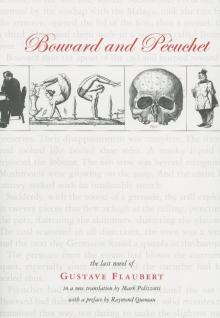 Bouvard and Pecuchet
Bouvard and Pecuchet Madame Bovary
Madame Bovary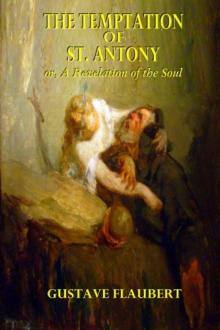 The Temptation of St. Antony
The Temptation of St. Antony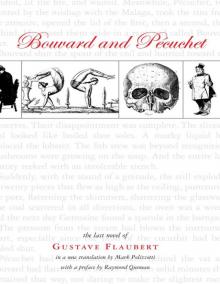 Bouvard and Pécuchet: A Tragi-comic Novel of Bourgeois Life, part 1
Bouvard and Pécuchet: A Tragi-comic Novel of Bourgeois Life, part 1 Three Tales
Three Tales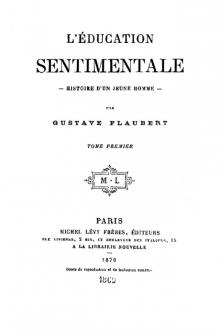 Education sentimentale. English
Education sentimentale. English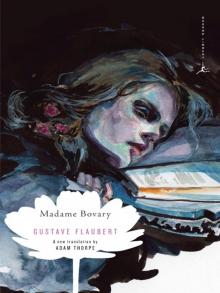 Madame Bovary (Modern Library)
Madame Bovary (Modern Library)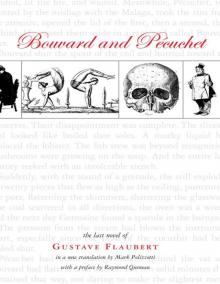 Bouvard and Pécuchet: A Tragi-comic Novel of Bourgeois Life, part 2
Bouvard and Pécuchet: A Tragi-comic Novel of Bourgeois Life, part 2 Sentimental Education; Or, The History of a Young Man. Volume 1
Sentimental Education; Or, The History of a Young Man. Volume 1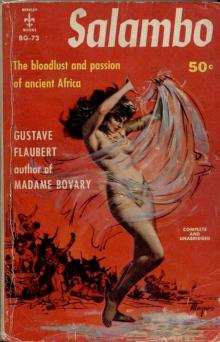 Salammbo
Salammbo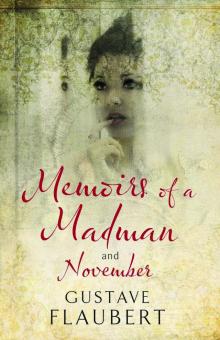 Memoirs of a Madman and November
Memoirs of a Madman and November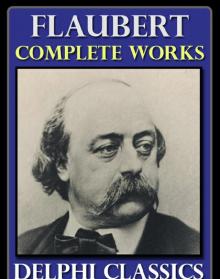 Complete Works of Gustave Flaubert
Complete Works of Gustave Flaubert